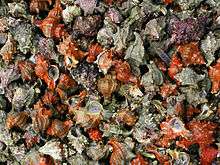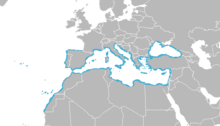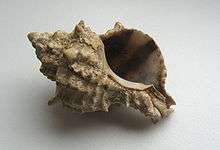Hexaplex trunculus
| Hexaplex trunculus | |
|---|---|
 | |
| Hexaplex trunculus | |
 | |
| Hexaplex trunculus | |
| Scientific classification | |
| Kingdom: | Animalia |
| Phylum: | Mollusca |
| Class: | Gastropoda |
| (unranked): | clade Caenogastropoda clade Hypsogastropoda clade Neogastropoda |
| Superfamily: | Muricoidea |
| Family: | Muricidae |
| Genus: | Hexaplex |
| Subgenus: | Trunculariopsis[1] |
| Species: | H. trunculus |
| Binomial name | |
| Hexaplex trunculus | |
| Synonyms | |
Hexaplex trunculus (also known as Murex trunculus, Phyllonotus trunculus, or the banded dye-murex) is a medium-sized sea snail, a marine gastropod mollusk in the family Muricidae, the murex shells or rock snails.
The snail appears in fossil records dating between the Pliocene and Quaternary periods (between 3.6 and 0.012 million years ago). Fossilized shells have been found in Morocco, Italy, and Spain.[2]
This sea snail is historically important because its hypobranchial gland secretes a mucus used to create a distinctive purple-blue indigo dye. Ancient Mediterranean cultures, including the Minoans, Canaanites/Phoenicians, Hebrews, and classical Greeks created dyes from the snails. One of the dye's main chemical ingredients is dibromo-indigotin. The dye will turn indigo blue, similar to the color of blue jeans, if exposed to sunlight before the dye sets.
Distribution

This species lives in the Mediterranean Sea and the Atlantic coasts of Europe and Africa, specifically Spain, Portugal, Morocco, the Canary Islands, Azores.[1]
This murex occurs in shallow, sublittoral waters.
Shell description
Hexaplex trunculus has a broadly conical shell about 4 to 10 cm long. It has a rather high spire with seven angulated whorls. The shell is variable in sculpture and coloring with dark banding, in four varieties. The ribs sometimes develop thickenings or spines and give the shell a rough appearance.
 Apertural view of a shell |
.jpg) Dorsal view of a shell |
Fossil shell of Hexaplex trunculus conglobatus from Pliocene |
Human use
Snail secretions were used as dye in ancient times. People still eat the snail in Portugal.[3]
As ancient dye
The purple dye originated in Phoenician colonies. The Phoenician port cities on the coast of current-day Lebanon, exported the dye across the Mediterranean.

The ancient method for mass-producing purple-blue dye from Hexaplex trunculus has not been successfully reproduced; the purplish hue quickly degrades, resulting in blue only. Nonetheless, archeologists have confirmed Hexaplex trunculus as the species used to create the purple-blue dye; large numbers of shells were recovered from inside ancient live-storage chambers that were used for harvesting. Apparently, 10- to 12,000 murex yielded only one gram of dye. Because of this, the dye was highly prized. Also known as Royal Purple, it was prohibitively expensive and was only used by the highest ranking aristocracy.
A similar dye, Tyrian purple, which is purple-red in color, was made from a related species of marine snail, Murex brandaris. This dye (alternatively known as imperial purple, see purple) was also prohibitively expensive.
Jews used the pigment from the shells to create a sky-blue, tekhelet, dye to put on the fringes that the Torah specifies for the corner of the prayer shawl. There are many opinions about how the tzitzit are tied. This blue dye was made by taking the yellow dye solution and letting it sit in the sunlight, and then dipping the wool in it. This dye was lost to history until it was rediscovered by Professor Otto Elsner of the Shenkar College of Fibers in Haifa. Since then, it has been re-introduced as the authentic ticheiles and has once again been reenstated to the Jewish garment [4] although only with limited acceptance.
References
- 1 2 Houart, R.; Gofas, S. (2009). "Hexaplex trunculus (Linnaeus, 1758)". In Bouchet, P.; Gofas, S.; Rosenberg, G. World Marine Mollusca Database. World Register of Marine Species. Retrieved 2010-05-05.
- ↑ Fossilworks
- ↑ Vasconcelos, P.; Carvalho, S.; Castro, M.; Gaspar, M. B. (2008). "The artisanal fishery for muricid gastropods (banded murex and purple dye murex) in the Ria Formosa lagoon (Algarve coast, southern Portugal)" (pdf). Scientia Marina. 72 (2): 287–298. doi:10.3989/scimar.2008.72n2287.
- ↑ http://tekhelet.com/tekhelet/introduction-to-tekhelet/